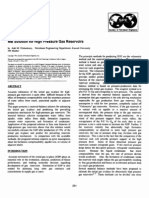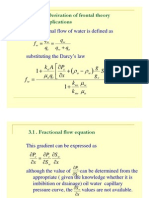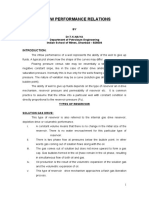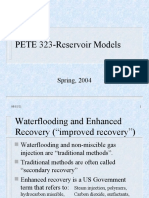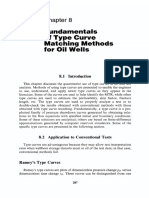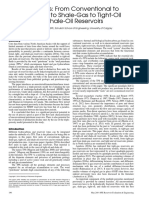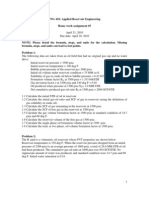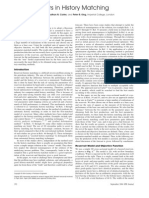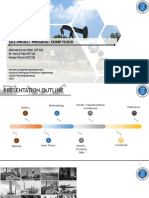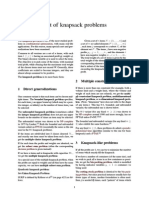Analyzing Well Production Data by Use of Combined Type-Curve-And Decline-Curve-Analysis Concepts
Analyzing Well Production Data by Use of Combined Type-Curve-And Decline-Curve-Analysis Concepts
Uploaded by
nicolascm94Copyright:
Available Formats
Analyzing Well Production Data by Use of Combined Type-Curve-And Decline-Curve-Analysis Concepts
Analyzing Well Production Data by Use of Combined Type-Curve-And Decline-Curve-Analysis Concepts
Uploaded by
nicolascm94Original Description:
Original Title
Copyright
Available Formats
Share this document
Did you find this document useful?
Is this content inappropriate?
Copyright:
Available Formats
Analyzing Well Production Data by Use of Combined Type-Curve-And Decline-Curve-Analysis Concepts
Analyzing Well Production Data by Use of Combined Type-Curve-And Decline-Curve-Analysis Concepts
Uploaded by
nicolascm94Copyright:
Available Formats
P R O D U C T I O N
T E C H N O L O G Y
ANALYZING WELL PRODUCTION DATA
BY USE OF COMBINED TYPE-CURVE- AND
DECLINE-CURVE-ANALYSIS CONCEPTS
Estimation of hydrocarbons in place is
required to determine the economic viability of project development and to satisfy
requirements of regulatory agencies.
During the past 50 years, various methods
have been developed for estimating
reserves from high-permeability oil reservoirs and low-permeability gas reservoirs.
These methods range from basic materialbalance methods to decline- and type-curve
analysis. They have varying limitations and
are based on analytical solutions, graphical
solutions, and a combination of the two.
Decline-curve-analysis methods have
been used for the past 50 years to analyze
production data and forecast reserves. Typecurve-analysis methods have become popular during the last 30 years to analyze pressure-transient-test data. Pressure-transient
data can be costly to obtain and may not be
available for many wells, while production
data are collected routinely and are available
from industry databases. New productiondecline type curves provide a method that
uses readily available well production data
to perform pressure-transient analysis.
These new production-decline type curves
represent an improvement over previous
work because a clearer distinction can be
made between transient- and boundarydominated-flow periods. The new curves
also contain derivative functions similar to
those used in the pressure-transient literature to aid in the matching process. The fulllength paper documents new productiondecline type curves for estimating reserves
and determining other reservoir parameters
for oil and gas wells by use of production
data. Solutions for constant-rate or conThis article is a synopsis of paper SPE
49222, Analyzing Well Production
Data Using Combined Type-Curve- and
Decline-Curve-Analysis Concepts, by
R.G. Agarwal, SPE, D.C. Gardner, SPE,
S.W. Kleinsteiber, SPE, and D.D.
Fussell, SPE, Amoco E&P Co., originally presented at the 1998 SPE Annual
Technical Conference and Exhibition,
New Orleans, 2730 September.
76
stant-bottomhole-pressure (BHP) production for oil and gas can be converted to
equivalent constant-rate liquid solutions.
BACKGROUND
Transient- and Pseudosteady-State-Flow
Conditions. A well is in a transient condition from the time it is first opened to flow
until the production from the well affects
the total reservoir system. At that time, the
well begins flowing under a pseudosteadystate- or a boundary-dominated-flow condition. Transient-rate and -pressure data are
used to determine reservoir permeability,
near-wellbore conditions, and fracture
length and conductivity. Pseudosteadystate data are required to estimate fluid in
place and reserves.
DISCUSSION
The first objective of this study was to verify, by use of a single-phase finite-difference
reservoir simulator, that constant-rate and
-BHP solutions for liquid and gas systems
can be converted to an equivalent constantrate liquid solution. Constant-rate liquid
solutions are well-understood for both
transient and pseudosteady-state conditions and are used widely for pressure-transient-analysis purposes. With constant-rate
liquid solutions, many well-known pressure-transient-analysis techniques can be
used to plot decline-curve data on different
types of graph paper.
Dimensionless Variables. Dimensionless
variables frequently used in type curves for
pressure-transient analysis are dimensionless wellbore pressure, pwD, and its derivatives with respect to dimensionless time
and with respect to the log of dimensionless
time. Reciprocals of pwD and its derivatives
plotted vs. dimensionless time can be used
to make a type-curve graph appear like a
decline curve.
CONSTANT-RATE AND -BHP
EQUIVALENCE
Liquid Solutions. Two radial-liquid-system
cases were considered. The two systems
were identical, except in one case the well
was produced at a constant rate and in the
other the well was produced at a constant
BHP. Comparing the graphs of both cases
shows that the two sets of results are very
similar during the transition period, but that
they are quite different for the pseudosteady-state period. Constant-BHP results
replotted with a modified time are equivalent to the constant-rate solutions. Gas in
place (GIP) can be estimated from this plot.
Gas Solutions. Two radial gas systems, one
a constant-rate case and the other a constant-BHP case, were considered. During the
transition period, constant-rate and -BHP
cases appear identical. The difference
between the two cases during the pseudosteady-state period is significant. This is to
be expected because of variations in gas
properties. To obtain equivalent solutions,
first a dimensionless time based on the modified time instead of real time is used. Then,
time is redefined in terms of pseudotime,
where a gas-properties product is calculated
as a function of average reservoir pressure.
After these modifications, the two gas cases
are identical during both the transient and
pseudosteady-state periods, verifying that it
is possible to convert constant-BHP liquid as
well as constant-rate and -BHP gas cases into
an equivalent constant-rate liquid case.
PRODUCTION-DECLINE
TYPE CURVES
The full-length paper presents three categories of new decline type curves: (1)
rate/time, (2) rate/cumulative production,
and (3) cumulative production/time.
Rate/Cumulative-Production Curves. A
graph commonly made by operations and
field engineers is rate or normalized rate as
a function of cumulative production. To
investigate the character of these graphs,
dimensionless groups 1/pwD and the derivative of pwD with respect to dimensionless
cumulative production, QpD, were plotted
as functions of QpD. Fig. 1 shows the results
in the form of type curves for radial-flow
OCTOBER 1998
P R O D U C T I O N
T E C H N O L O G Y
re/rwa produce a single curve during transient flow. During pseudosteady-state flow,
the curves diverge and become flat.
ABOUT TYPE CURVES
Fig. 1Rate/cumulative-production-decline type curves for radial flow, r e=reservoir
radius, ft; rwa=apparent wellbore radius, ft.
systems for reservoir radius/wellbore
radius, re/rwa, values of 10,000, 1,000, and
100. During the pseudosteady-state-flow
period, the 1/pwD curves become linear and
converge at QpD=1/(2)=0.159. This is
called an anchor-point value and is useful
in estimating GIP. For an optimistic estimate of GIP, the trajectory of the field data
undershoots the anchor point; for a pessimistic estimate of GIP, it overshoots the
anchor point. This graph is very useful in
converging on a correct value of GIP.
Cumulative-Production/Time Curves.
These curves are useful because field
cumulative-production data are often
smoother than the corresponding rate data.
Fig. 2 shows dimensionless cumulative
production, QpD, as a function of re/rwa
plotted vs. dimensionless time. All values of
Dimensionless Time
Fig. 2Cumulative production vs. time production-decline type curves for radial flow.
OCTOBER 1998
The type curves presented in Figs. 9 to 19
in the full-length paper represent a new
contribution to technology and contribute
to recent work within the industry in
advanced type-curve methods. Recent
developments from several published
sources are integrated into more complete
sets of type curves for both radial and fracture flow in both transient- and boundarydominated-flow conditions. Derivative type
curves from both radial and fracture flow in
terms of dimensionless rate and rate derivatives vs. dimensionless time that are based
on normalized rate and equivalent fluid
properties are included. New dimensionless-rate and rate-derivative type curves in
terms of QpD were created.
The new suite of type curves considers
both transient and pseudosteady-state conditions as well as the transition between the
two. They can be generated easily by use of
a reservoir simulator for any desired flow
system, such as radial flow and vertically
fractured wells.
CONCLUSIONS
1. A new set of rate/time, rate/cumulativeproduction, and cumulative-production/time
production-decline type curves and their
associated derivatives was developed with
pressure-transient-analysis concepts.
2. These curves were developed for
radial systems as well as vertically fractured wells with infinite- and finite-conductivity fractures.
3. These new production-decline type
curves represent an advancement over previous work because a clearer distinction
can be made between transient- and
boundary-dominated-flow periods.
4. These curves provide a practical tool
for field engineers to estimate reservoir permeability, skin effect, fracture length, and
fracture conductivity.
5. These type curves use routinely collected production data and those available
from industry databases to replace costly
pressure-transient-test data.
Please read the full-length paper for
additional detail, illustrations, and references. The paper from which the synopsis has been taken has not been peer
reviewed.
77
You might also like
- Spe 99668 MSDocument14 pagesSpe 99668 MSCamilo Andrés GuerreroNo ratings yet
- 03 - Fast Evaluation of Well Placements in Heterogeneous Reservoir Models Using Machine LearningDocument13 pages03 - Fast Evaluation of Well Placements in Heterogeneous Reservoir Models Using Machine LearningAli NasserNo ratings yet
- Well Test - Boundary - 2 Week 09Document47 pagesWell Test - Boundary - 2 Week 09robbi sobariNo ratings yet
- Presentation of Chinese Codes Safety Concept, Material Resistance, Load CombinationsDocument66 pagesPresentation of Chinese Codes Safety Concept, Material Resistance, Load CombinationsdaeealiNo ratings yet
- Analyzing Well Production Data Using Combined-Type-Curve and Decline-Curve Analysis ConceptsDocument9 pagesAnalyzing Well Production Data Using Combined-Type-Curve and Decline-Curve Analysis ConceptsDull MárquezNo ratings yet
- Deliverability Testing of Gas Wells - PetroWikiDocument9 pagesDeliverability Testing of Gas Wells - PetroWikidarshanNo ratings yet
- Material BalanceDocument12 pagesMaterial BalanceAvinash PatilNo ratings yet
- − ∂ ∂x ρ = ∂ ∂t φρ, = o,w,g: Oil-Water Simulation - Impes SolutionDocument12 pages− ∂ ∂x ρ = ∂ ∂t φρ, = o,w,g: Oil-Water Simulation - Impes SolutionBrandon Sloan100% (1)
- Waterflooding - Macroscopic Effficiency Relations (Compatibility Mode)Document36 pagesWaterflooding - Macroscopic Effficiency Relations (Compatibility Mode)Hu Kocabas100% (1)
- Lecture 5 Inflow Peorformance RelationsDocument14 pagesLecture 5 Inflow Peorformance RelationsMahesh sinhaNo ratings yet
- Blasingame Decline Type CurveDocument6 pagesBlasingame Decline Type Curvecamelion3No ratings yet
- Artificial Lift SelectionDocument15 pagesArtificial Lift Selectionمحمد المحموديNo ratings yet
- SPE30714 Fevang WhitsonDocument16 pagesSPE30714 Fevang WhitsonMohamed El KikiNo ratings yet
- Critical Rate For Water ConingDocument8 pagesCritical Rate For Water ConingHari HaranNo ratings yet
- Production Decline AnalysisDocument55 pagesProduction Decline AnalysisRagu Navya SreeNo ratings yet
- MSC Thesis Jules B VestersDocument74 pagesMSC Thesis Jules B VestersPriozky Pratama PurbaNo ratings yet
- PETE323 Module III 04ADocument100 pagesPETE323 Module III 04AMostafa ElghifaryNo ratings yet
- Definitions ReserveDocument13 pagesDefinitions Reservejoo123456789No ratings yet
- Decline Curve Analysis John LeeDocument33 pagesDecline Curve Analysis John LeeEngr Sadiq WazirNo ratings yet
- Eclipse Project1 - JuLy 2010Document7 pagesEclipse Project1 - JuLy 2010Nahvin JayaratnamNo ratings yet
- Multiphase Flow in WellsDocument149 pagesMultiphase Flow in WellsColin JordanNo ratings yet
- SPE-14098-PA Raghavan Well-Test Analysis For Multiphase FlowDocument10 pagesSPE-14098-PA Raghavan Well-Test Analysis For Multiphase FlowLorena CamposNo ratings yet
- Chapter 8 - Fundamentals of Type Curve Matching Methods For Oil WellsDocument52 pagesChapter 8 - Fundamentals of Type Curve Matching Methods For Oil WellsmisterkoroNo ratings yet
- Eor Shale Co2Document8 pagesEor Shale Co2Anand SelveindranNo ratings yet
- Aguilera 2014Document19 pagesAguilera 2014rafaelNo ratings yet
- Gas - in - Place - A - Volumetrics - I. KocabasDocument31 pagesGas - in - Place - A - Volumetrics - I. KocabasTadeo ChoqueNo ratings yet
- WT PresentationDocument27 pagesWT Presentation503238196010No ratings yet
- Part 16 Horizontal Well TestingDocument16 pagesPart 16 Horizontal Well TestingChai CwsNo ratings yet
- Kal War 2017Document10 pagesKal War 2017khusnul9No ratings yet
- Dynamic Material Balance Oil or Gas in Place Without ShutInsDocument6 pagesDynamic Material Balance Oil or Gas in Place Without ShutInsMUHAMMED FUADNo ratings yet
- 0 Welcome Intro''Document9 pages0 Welcome Intro''Lija BinuNo ratings yet
- Tutorial 2Document7 pagesTutorial 2Jaime HernandezNo ratings yet
- Chapter 8: Production Decline Analysis: BQ DT DQ QDocument24 pagesChapter 8: Production Decline Analysis: BQ DT DQ QbehnamjpNo ratings yet
- C o U R S e N o - PENG 331 Reservoir EngineeringDocument3 pagesC o U R S e N o - PENG 331 Reservoir Engineeringtassili17No ratings yet
- Aquifer Modelling PDFDocument21 pagesAquifer Modelling PDFAminGutierrezNo ratings yet
- Reservoir Simulation TPADocument56 pagesReservoir Simulation TPAYash GurjarNo ratings yet
- Complete Download Dynamic Well Testing in Petroleum Exploration and Development 2nd Edition Huinong Zhuang PDF All ChaptersDocument48 pagesComplete Download Dynamic Well Testing in Petroleum Exploration and Development 2nd Edition Huinong Zhuang PDF All Chaptersreirajhow100% (4)
- Secondary Recorvery in Dulang FieldDocument10 pagesSecondary Recorvery in Dulang FieldEga Puspita LerianaNo ratings yet
- A New Decline Curve Analysis Method For Layered ReservoirsDocument16 pagesA New Decline Curve Analysis Method For Layered ReservoirsNicoNopriantoSihombingNo ratings yet
- HW5Document2 pagesHW5Mohammad Iqbal Mahamad Amir100% (1)
- Dynamic Production System Nodal AnalysisDocument7 pagesDynamic Production System Nodal AnalysisTopiksarip05No ratings yet
- Ajsute VLPDocument40 pagesAjsute VLPMarcelo Ayllón RiberaNo ratings yet
- Taller 1Document5 pagesTaller 1José Fernando TerronesNo ratings yet
- (Blasingame) SPE 103204Document27 pages(Blasingame) SPE 103204juan joseNo ratings yet
- Rate Time AnalysisDocument162 pagesRate Time AnalysisSmail KechamNo ratings yet
- Errors in History MatchingDocument10 pagesErrors in History MatchingUkpabio EyoNo ratings yet
- This Paper Reviews The Standard Experiments Performed in Laboratories About Constant Composition ExpansionDocument5 pagesThis Paper Reviews The Standard Experiments Performed in Laboratories About Constant Composition Expansionyayay yayayaNo ratings yet
- Intgration MangmentDocument17 pagesIntgration MangmentAli Mahmoud100% (1)
- Equilibrium Ratio Prediction and CalculationDocument28 pagesEquilibrium Ratio Prediction and CalculationweldsvNo ratings yet
- Week 4 Dump FloodDocument37 pagesWeek 4 Dump FloodMuhamad HairulNo ratings yet
- Introduction To Reservoir EngineeringDocument3 pagesIntroduction To Reservoir Engineeringابوالحروف العربي ابوالحروفNo ratings yet
- School of Geology, Petroleum and Mining Engineering Petroleum Engineering DepartmentDocument7 pagesSchool of Geology, Petroleum and Mining Engineering Petroleum Engineering DepartmentAimiNo ratings yet
- Advanced Gas Material Balance in Simplified Format: S. Moghadam, O. Jeje, and L. Mattar, Fekete Associates IncDocument9 pagesAdvanced Gas Material Balance in Simplified Format: S. Moghadam, O. Jeje, and L. Mattar, Fekete Associates IncAmr HegazyNo ratings yet
- 22 - Relative Permeability Effects On The Miscible CO2 WAG Injection SchemesDocument9 pages22 - Relative Permeability Effects On The Miscible CO2 WAG Injection SchemesheviNo ratings yet
- Lecture10 PTEG-431 SinglePhase 19.09.2018Document48 pagesLecture10 PTEG-431 SinglePhase 19.09.2018Akhil GodavarthiNo ratings yet
- Week 5 Dump FloodDocument42 pagesWeek 5 Dump FloodMuhamad HairulNo ratings yet
- Week 3.5-Multirate Test PDFDocument23 pagesWeek 3.5-Multirate Test PDFSyafiq JaafarNo ratings yet
- SPE-68885-JPT Paper de Crudos Espumoso PDFDocument7 pagesSPE-68885-JPT Paper de Crudos Espumoso PDFPatriciaAmorinNo ratings yet
- Reservoir Engineering of Conventional and Unconventional Petroleum ResourcesFrom EverandReservoir Engineering of Conventional and Unconventional Petroleum ResourcesNo ratings yet
- Formation Testing: Pressure Transient and Contamination AnalysisFrom EverandFormation Testing: Pressure Transient and Contamination AnalysisNo ratings yet
- Skateboard Parabola ProjectDocument11 pagesSkateboard Parabola Projectnmstar56No ratings yet
- KKKKKKKKKKKKKKKKKKKKKKKKKKKKKKKKKKKKKKKKKKKHJHJKJDocument2 pagesKKKKKKKKKKKKKKKKKKKKKKKKKKKKKKKKKKKKKKKKKKKHJHJKJreenuNo ratings yet
- BP ChromatographyDocument12 pagesBP Chromatographymeanangel4No ratings yet
- AC CalculationDocument8 pagesAC CalculationFauzi RahmanNo ratings yet
- Wei Rong: Explanation of The Load Case CombinationDocument4 pagesWei Rong: Explanation of The Load Case CombinationSharun SureshNo ratings yet
- Unit 3 - Chemistry - WWW - Rgpvnotes.inDocument16 pagesUnit 3 - Chemistry - WWW - Rgpvnotes.inN S PatidarNo ratings yet
- Gradient Notes PDFDocument7 pagesGradient Notes PDFAlbert JordanNo ratings yet
- HFSS Radar Cross SectionDocument33 pagesHFSS Radar Cross SectionMohamad SalehNo ratings yet
- 2-Steady State ConductionDocument34 pages2-Steady State ConductionKayhan SaiedNo ratings yet
- Chapter 6 - Sampling TheoryDocument32 pagesChapter 6 - Sampling TheoryMuhammad Aljamal100% (1)
- Some Parametric Solutions To The Navier-Lame Equation in Cylindrical Coordinates Using Buchwald Displacement PotentialsDocument30 pagesSome Parametric Solutions To The Navier-Lame Equation in Cylindrical Coordinates Using Buchwald Displacement PotentialsraveneyesdeadNo ratings yet
- Streamlines NumericalsDocument2 pagesStreamlines Numericalscharlesvictor1980No ratings yet
- ES.1803 Topic 25 Notes: Jeremy OrloffDocument17 pagesES.1803 Topic 25 Notes: Jeremy OrloffPeper12345No ratings yet
- Left Right Pseudo-Inverse PDFDocument4 pagesLeft Right Pseudo-Inverse PDFYang CaoNo ratings yet
- 5 - Three Moment Equation For Continuous BeamDocument19 pages5 - Three Moment Equation For Continuous BeamhyuriyyNo ratings yet
- Skylab 4 PAO Mission Commentary 23 of 32Document214 pagesSkylab 4 PAO Mission Commentary 23 of 32Bob AndrepontNo ratings yet
- Super Tear Gas (CS)Document173 pagesSuper Tear Gas (CS)Reid Kirby100% (1)
- Algorithm To Construct Super Vertex Magic Total Labeling of Complete GraphsDocument5 pagesAlgorithm To Construct Super Vertex Magic Total Labeling of Complete GraphsInternational Journal of Application or Innovation in Engineering & ManagementNo ratings yet
- Monographie BtttyrtIPM-5 Tables Vol7Document246 pagesMonographie BtttyrtIPM-5 Tables Vol7arengifoipenNo ratings yet
- 720-C-003 (LP Methanol Column)Document7 pages720-C-003 (LP Methanol Column)idilfitriNo ratings yet
- Unit 2 Tacheometric Surveying: StructureDocument14 pagesUnit 2 Tacheometric Surveying: Structuresharonlly toumasNo ratings yet
- Working With MicrospheresDocument20 pagesWorking With MicrospheresSreeman MypatiNo ratings yet
- List of Knapsack Problems: 2 Multiple ConstraintsDocument3 pagesList of Knapsack Problems: 2 Multiple ConstraintssaiNo ratings yet
- VBS Purvanchal University, Jaunpur: Physics M.Sc. (FINAL)Document8 pagesVBS Purvanchal University, Jaunpur: Physics M.Sc. (FINAL)Mohit MishraNo ratings yet
- N66067216 Final Project Plaxis 2DDocument11 pagesN66067216 Final Project Plaxis 2DBagas AryasetaNo ratings yet
- Chapter 3.2 Ampere's Circuital Law and Its ApplicationsDocument22 pagesChapter 3.2 Ampere's Circuital Law and Its ApplicationsHarsh Mehta50% (2)
- (International Union of Crystallography Monographs on Crystallography 18) Frank H. Herbstein - Crystalline Molecular Complexes and Compounds_ Structure and Principles 2 Volume Set (International Union(1)Document1,310 pages(International Union of Crystallography Monographs on Crystallography 18) Frank H. Herbstein - Crystalline Molecular Complexes and Compounds_ Structure and Principles 2 Volume Set (International Union(1)Joakin Bahamondes100% (2)
- Pro e Surface ModelingDocument21 pagesPro e Surface ModelingRahul100% (1)
- Chapter 9 (472-477)Document7 pagesChapter 9 (472-477)T Ara AgathaNo ratings yet






